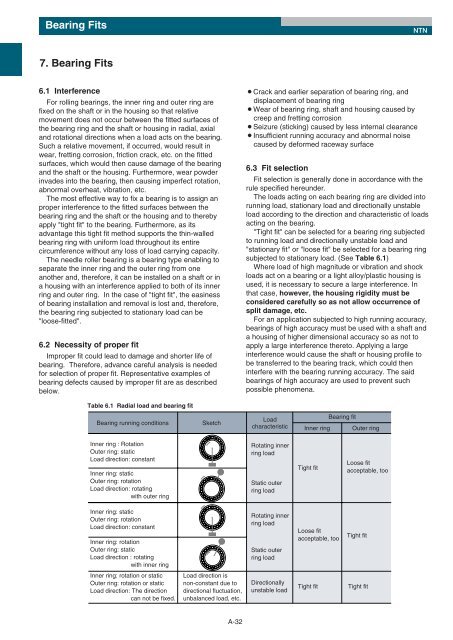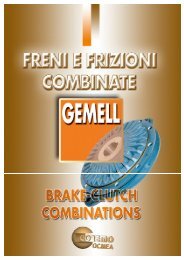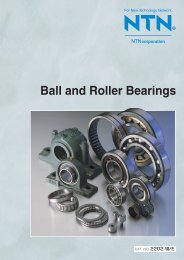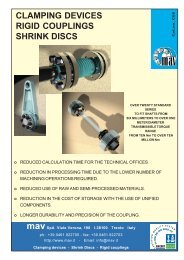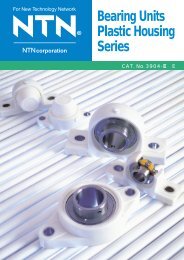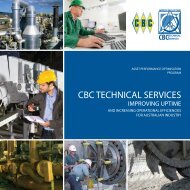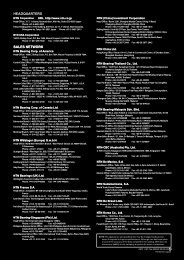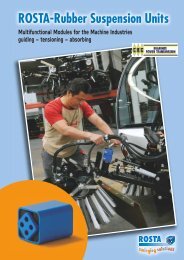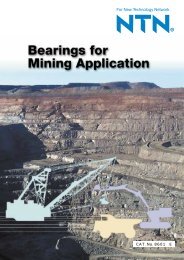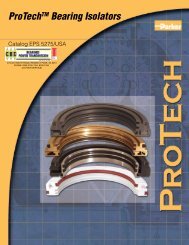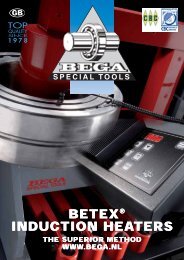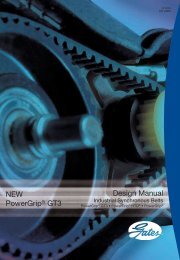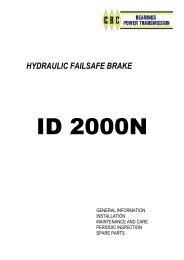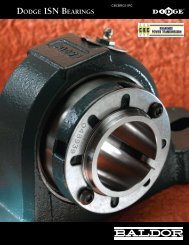Needle Roller Bearings - Ntn-snr.com
Needle Roller Bearings - Ntn-snr.com
Needle Roller Bearings - Ntn-snr.com
Create successful ePaper yourself
Turn your PDF publications into a flip-book with our unique Google optimized e-Paper software.
Bearing Fits<br />
NTN<br />
7. Bearing Fits<br />
6.1 Interference<br />
For rolling bearings, the inner ring and outer ring are<br />
fixed on the shaft or in the housing so that relative<br />
movement does not occur between the fitted surfaces of<br />
the bearing ring and the shaft or housing in radial, axial<br />
and rotational directions when a load acts on the bearing.<br />
Such a relative movement, if occurred, would result in<br />
wear, fretting corrosion, friction crack, etc. on the fitted<br />
surfaces, which would then cause damage of the bearing<br />
and the shaft or the housing. Furthermore, wear powder<br />
invades into the bearing, then causing imperfect rotation,<br />
abnormal overheat, vibration, etc.<br />
The most effective way to fix a bearing is to assign an<br />
proper interference to the fitted surfaces between the<br />
bearing ring and the shaft or the housing and to thereby<br />
apply "tight fit" to the bearing. Furthermore, as its<br />
advantage this tight fit method supports the thin-walled<br />
bearing ring with uniform load throughout its entire<br />
circumference without any loss of load carrying capacity.<br />
The needle roller bearing is a bearing type enabling to<br />
separate the inner ring and the outer ring from one<br />
another and, therefore, it can be installed on a shaft or in<br />
a housing with an interference applied to both of its inner<br />
ring and outer ring. In the case of "tight fit", the easiness<br />
of bearing installation and removal is lost and, therefore,<br />
the bearing ring subjected to stationary load can be<br />
"loose-fitted".<br />
6.2 Necessity of proper fit<br />
Improper fit could lead to damage and shorter life of<br />
bearing. Therefore, advance careful analysis is needed<br />
for selection of proper fit. Representative examples of<br />
bearing defects caused by improper fit are as described<br />
below.<br />
¡Crack and earlier separation of bearing ring, and<br />
displacement of bearing ring<br />
¡Wear of bearing ring, shaft and housing caused by<br />
creep and fretting corrosion<br />
¡Seizure (sticking) caused by less internal clearance<br />
¡Insufficient running accuracy and abnormal noise<br />
caused by deformed raceway surface<br />
6.3 Fit selection<br />
Fit selection is generally done in accordance with the<br />
rule specified hereunder.<br />
The loads acting on each bearing ring are divided into<br />
running load, stationary load and directionally unstable<br />
load according to the direction and characteristic of loads<br />
acting on the bearing.<br />
"Tight fit" can be selected for a bearing ring subjected<br />
to running load and directionally unstable load and<br />
"stationary fit" or "loose fit" be selected for a bearing ring<br />
subjected to stationary load. (See Table 6.1)<br />
Where load of high magnitude or vibration and shock<br />
loads act on a bearing or a light alloy/plastic housing is<br />
used, it is necessary to secure a large interference. In<br />
that case, however, the housing rigidity must be<br />
considered carefully so as not allow occurrence of<br />
split damage, etc.<br />
For an application subjected to high running accuracy,<br />
bearings of high accuracy must be used with a shaft and<br />
a housing of higher dimensional accuracy so as not to<br />
apply a large interference thereto. Applying a large<br />
interference would cause the shaft or housing profile to<br />
be transferred to the bearing track, which could then<br />
interfere with the bearing running accuracy. The said<br />
bearings of high accuracy are used to prevent such<br />
possible phenomena.<br />
Table 6.1 Radial load and bearing fit<br />
Bearing running conditions<br />
Sketch<br />
Load<br />
characteristic<br />
Bearing fit<br />
Inner ring Outer ring<br />
Inner ring : Rotation<br />
Outer ring: static<br />
Load direction: constant<br />
Inner ring: static<br />
Outer ring: rotation<br />
Load direction: rotating<br />
with outer ring<br />
Rotating inner<br />
ring load<br />
Static outer<br />
ring load<br />
Tight fit<br />
Loose fit<br />
acceptable, too<br />
Inner ring: static<br />
Outer ring: rotation<br />
Load direction: constant<br />
Inner ring: rotation<br />
Outer ring: static<br />
Load direction : rotating<br />
with inner ring<br />
Inner ring: rotation or static<br />
Outer ring: rotation or static<br />
Load direction: The direction<br />
can not be fixed.<br />
Rotating inner<br />
ring load<br />
Static outer<br />
ring load<br />
Loose fit<br />
acceptable, too<br />
Tight fit<br />
Load direction is<br />
non-constant due to<br />
directional fluctuation,<br />
unbalanced load, etc.<br />
Directionally<br />
unstable load<br />
Tight fit<br />
Tight fit<br />
A-32


